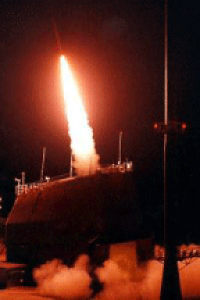TOP > Topics > 2004 > ISAS observed the wavy airglow structure successfully with a sounding rocket "S-310-33" .
![]()
ISAS observed the wavy airglow structure successfully with a sounding rocket "S-310-33" .
The Institute of Space and Astronautical Science (ISAS) of Japan Aerospace Exploration Agency (JAXA) launched a sounding rocket “S-310-33” with an elevation angle of 72 deg at 00:30 AM on January 18, 2004, from JAXA’s Uchinoura Space Center (USC) in Uchinoura, Kagoshima Pref. The purpose of this rocket is to investigate a mystery of the wavy airglow structure that is sometimes observed to exist in the lower ionosphere. Observations by the physical instruments onboard were successfully conducted as planned. A group of scientists working on this project has immediately started analyzing the observation data in order to elucidate the generation mechanism of a wavy pattern of the airglow.
The rocket flight as well as operations of all the instruments onboard were confirmed to be normal as expected. The YO-YO despinner started its operation and the nose fairing was opened, at 55 sec and 60 sec from the launch, respectively. The rocket reached its highest altitude of 141 km at 186 sec after the launch, and the foil chaff was released at 277 sec during its down leg. The rocket finally landed on the water in the southeast sea of Uchinoura.
The oxygen atom instrument (NNP-O), airglow imager (AGL), Langmuir probe (FLP), and the medium-wave-band receiver (MFR) successfully measured the oxygen atom density, intensity of airglow, and the electron temperature, and plasma density, respectively, in the lower ionosphere accompanied by the wavy structure of the airglow. The speed and direction of the atmospheric wind above 80 km altitude were measured by tracking the chaff with the new precision radar during a period of 13 min. The imaging attitude finder (IAF) succeeded to determine the attitude of rocket by detecting stars.
The ground observation team could certainly observe a horizontal wavy structure of the emission layer of the airglow in the lower ionosphere. During this campaign, simultaneous observations of the atmospheric wind were carried out by the medium wave frequency (MF) in Yamagawa and MU radars in Shigaraki. In addition, the density and wind of Na+ ions were simultaneously measured with the LIDAR as well as the atmosphere temperature was estimated from the spectrometer observation.
Thus, valuable data have been obtained from this rocket experiment as we originally expect. It is promising that a further analysis of the data will bring an important progress on understanding of the generation mechanism of the wavy airglow structure.
|
January 19, 2004





